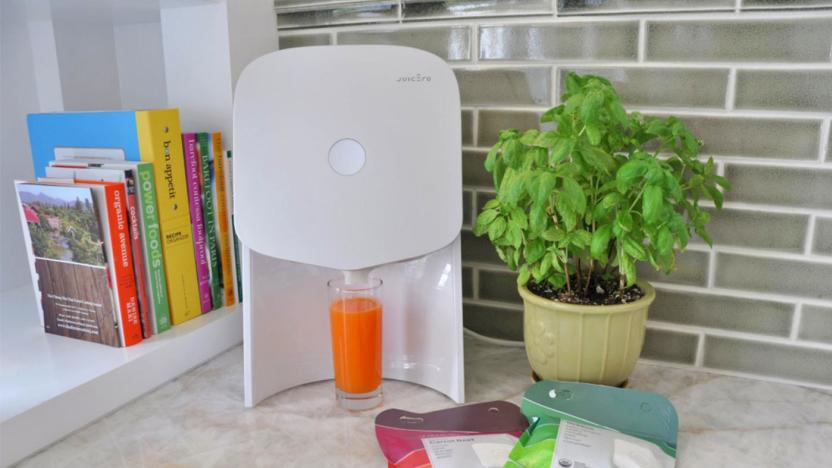juice
Latest

Juicero, the ridiculous $400 juicer company, is shutting down
Juicero -- the company that shot to notoriety last year for selling an overpriced, overly complicated juicer -- is closing up shop. The company is immediately suspending sales of its Juicero Press and Produce Packs, and is offering refunds for the next 90 days. Anyone looking to get their money back should hit up help@juicero.com by December 1st.

Juicero will refund unsatisfied buyers of its WiFi-connected press
We never bought the hype on Juicero's $700 connected cold-press machine, but the company's CEO says anyone who did pay for one can get their money back. In a blog post on Medium, CEO Jeff Dunn responded to a Bloomberg report that pointed out the company's produce packs can be squeezed by hand, without buying the juicer at all. According to Dunn, for the next 30 days any Juicero owner can return their machine for a full refund (since it launched, the price has dropped to $400) -- this courtesy presumably doesn't extend to any of the investors who backed it.

Now there's a $700 smart cold-pressed juice maker
The world needs a "magical" $700, subscription-based juicer apparently. At least that's what the folks behind Juicero seem to think. The 31.5-pound countertop device ticks a few buzzword boxes (farm to table, smart, organic, has a companion app) while catering to our inherent laziness. The apparent draw, according to Business Insider, is that there's no mess or work involved: put an IV-bag-sized pouch in the machine and it spits out a cup of cold-pressed juice while telling you its nutritional content.

Crowdfunding Project News: All Kickstarter this week
Every week, TUAW provides readers with an update on what new or significant crowdfunded Apple-related projects are in the news. While our policy is to not go into detail on items that haven't reached at least 80 percent of their funding goal, this update is designed to give readers a heads-up on projects they might find interesting enough to back. This week, we're taking a closer look at seven fascinating Kickstarter projects: The first pick of the week has already reached funding with a month to go, and it's not surprising. Dart is advertised as the world's smallest laptop power adapter, and it definitely will leave a lot more space in your computer bag. Imagine using one power "brick" to run your MacBook Pro and charge your favorite iOS devices -- that's what this project is all about. Right now you'll have to pledge $168 or more to get one of the MacBook Darts, but you'll be one of the first people in the world to get one of these diminutive power adapters. Probably the coolest project this week is a tiny little printer you can take with you anywhere. Instead of putting paper into a printer, you put this printer onto the paper and it moves around. At this point the ZUtA Pocket Printer Mini Mobile Robotic Printer is almost 94 percent funded with a little over three weeks to go, so it looks like it's going to make it to market. I wouldn't go so far as to say that this is the most practical or affordable printer -- it's rather slow and currently the least expensive pledge is $200 -- but when it comes to a technology that can finally change printing once and for all, this is it. What the world needs now is a USB wall charger with a wood grain finish! That's the concept behind iWoody, which looks a lot like the traditional iPhone/iPad charger but uses a water-transfer wood design to give it a unique look. iWoody might not make it to market -- it's only 2.5 percent funded with three weeks to go -- but if you're looking for an additional USB wall charger, you can pledge as little as $15 and get one. Charging of your electronic toys seems to be on the minds of a lot of Kickstarter inventors this week. The Juice is a beautiful aluminum on-wall iPad charging dock that would be perfect for home automation fans. It's gorgeous, it's sleek, and it's designed by a pair of German designers. And did I mention that it's made of Jony Ive's favorite material, al-you-minnie-yum? Check it out here. TUAW buddy Hal Sherman provided us with a couple of picks this week. The first is the Iron Brick Safe, which is the perfect accompaniment to an Apple laptop for a college student. It'll let them keep their MacBook nicely locked away in a dorm room. Of course, this thing has only $461 of funding for a $23,500 goal so far, with about three weeks to go, so the old "slide the MacBook Air under the mattress" trick might have to suffice for a while. Hal also provided us with a tip on the Mode Mount, a rack mounting system for the new Mac Pro. Unfortunately, this project also seems to be moving slowly in funding -- $433 pledged with a $50,000 goal -- so it might not make it to production. Insert comment here about Hal really being able to pick 'em... (just kidding, Hal) Our final entry this week is for the "Frog" Dolly, touted as a "portable and versatile 3D printed camera dolly". So what does that have to do with Apple? Well, one of the models of this cool filmmaking tool is app-controlled, so you'd be able do full motion control filming with your favorite 4K camera installed on the Frog. The Frog Dolly is already in production; this Kickstarter is to help reduce the cost of the devices so that more filmmakers -- pro and amateur -- can have access to an incredible tool. It's at about 13 percent funding with a little over three weeks to go. If you're aware of any other crowdfunded Apple-related projects, be sure to let us know about them through the Tip Us button at the upper right of the TUAW home page for future listing on the site. Just make sure that they actually have a valid reason for existing, OK?

Researchers create incredibly thin solar cells flexible enough to wrap around a human hair
You've probably heard that the sun is strong enough to power our planet many times over, but without a practical method of harnessing that energy, there's no way to take full advantage. An incredibly thin and light solar cell could go a long way to accomplishing that on a smaller scale, however, making the latest device from researchers from the University of Austria and the University of Tokyo a fairly significant discovery. Scientists were able to create an ultra-thin solar cell that measures just 1.9 micrometers thick -- roughly one-tenth the size of the next device. Not only is the sample slim -- composed of electrodes mounted on plastic foil, rather than glass -- it's also incredibly flexible, able to be wrapped around a single strand of human hair (which, believe it or not, is nearly 20 times thicker). The scalable cell could replace batteries in lighting, display and medical applications, and may be ready to be put to use in as few as five years. There's a bounty of physical measurement and efficiency data at the source link below, so grab those reading glasses and click on past the break.

New phase-change memory gets boost from carbon nanotubes, puts PRAM claims to shame
We've been hearing about the potential flash killer for years, and now a team of University of Illinois engineers is claiming that its new phase-change technology could make the PRAM of our dreams look quaint by comparison. Like so many groundbreaking discoveries of late, carbon nanotubes are at the heart of the this new mode of memory, which uses 100x less power than its phase-change predecessors. So, how does it work? Basically, the team replaced metal wires with carbon nanotubes to pump electricity through phase-change bits, reducing the size of the conductor and the amount of energy consumed. Still too much technobabble? How 'bout this -- they're using tiny tubes to give your cellphone juice for days. Get it? Good. [Thanks, Jeff]

Japan juiced for Ghost Trick: Phantom Detective
Ghost Trick is being promoted by Japan's "Juicer Bar" franchise with a themed juice drink, made of blackcurrant, blueberries, and a "mystery flavor." In keeping with the game, we're guessing it's arsenic -- you have to go back in time and possess the juice machine to stop your drink from being made.

Macworld clears up confusion around iPhone 'charge cycles'
In addition to confirming a widespread bug in the iPhone's charging meter, an Apple representative spoke with Macworld's Jason Snell to clear up some confusion surrounding the term 'charge cycle.' A lot of media outlets and iPhone haters are running a little too far with Apple's rating on the iPhone battery of '400 charge cycles,' assuming that, after plugging the phone in 400 times to charge up, the battery is dead or useless. As Snell states in his article, this couldn't be farther from the truth.To summarize: a charge cycle is defined as draining the battery and charging it back up - not simply plugging in to top off when you get home from work. According to Snell, charing your iPhone's battery up 25% is equivalent of spending 25% of a charge cycle - not the entire cycle. Further, after 400 charge cycles the battery is in absolutely no way dead or useless, nor is it in need of a warranty replacement or support from AppleCare. After those 400 cycles the battery's total capacity simply drops to about 80%, just like an iPod and many other lithium-based batteries. In other words: unless you're completely draining your battery every day and charging it back up completely every night, you shouldn't have anything to worry about for the life of your iPhone.While it may still be a bummer for some ultra-mobile users that the iPhone's battery isn't user-replaceable on the fly, it should still offer plenty of juice for the typical user's habits for many years to come.[via Daring Fireball]

DIY Kyoto's Wattson
If you haven't been conserving energy like any good citizen of the world -- carpooling, turning lights off when you leave the room, keeping your defibrillator unplugged -- perhaps it's about time you took your energy output into your own hands. We've seen juice-monitoring solutions before, but the Wattson definitely takes the cake for style and simplicity, showing a running total of wattage output represented in a digital readout or ambient light -- it can also connect to your PC and record usage patterns. Unfortunately you're going to have to spend £350 ($600 US) to get one, and that's if you're lucky enough to snag one of the limited run of 250 they manufactured. Elementary, my dear... ahem.[Via Inhabitat]






